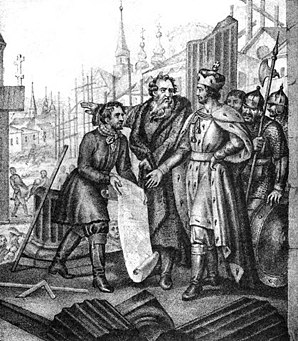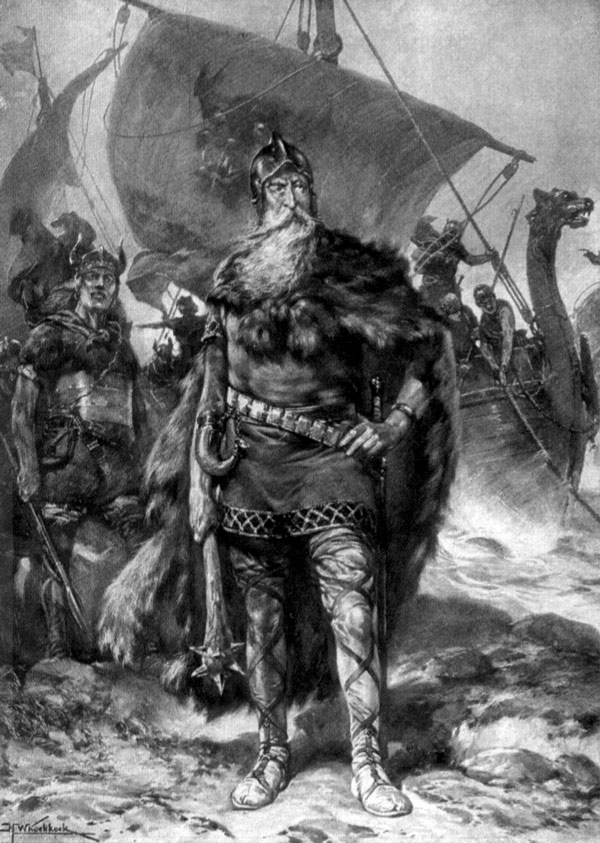Нов город = Nov gorod = New burgh / town Veliky Novgorod = Great Novgorod

Yaroslav II of Vladimir, who according to the Novgorod First Chronicle campaigned against the Finns in 1226 and 1228 and repelled their counter-campaign in 1228.
The same winter Yaroslav, son of Vsevolod left Novgorod over the sea against Yem where no else Russian prince had been able to dwell; and he conquered the land and returned to Novgorod praising God with many prisoners. When those who were accompanying him could not handle all the prisoners, they killed some of them but released many more.
The Yem retaliatory expedition in summer 1228 against Ladoga, allegedly with more than 2000 men ended in disaster, as described by the Novgorod First Chronicle.

13th-century Novgorod as represented

The bailiff of Ladoga castle (here in its 15th-century appearance) repelled the Yem forces in 1228.
The Yem came to Lake Ladoga to war, and word about that came to Novgorod on the Ascension Day of the Christ (6.8). And Novgorodians took their barges and rowed to Ladoga with prince Jaroslav. Vladislav, the bailiff at Ladoga, and the people of Ladoga did not wait for the Novgorodians, but went after them (Finns) in boats where they were fighting, met with them and fought them; and then came night, and they (people of Ladoga) landed on an island, but Finns were on the coast with prisoners, for they had been fighting close to the lake near the landing place, and in Olonets.The same night they asked for peace, but the bailiff and the people of Ladoga did not grant it; and they killed all the prisoners and ran into forests, after abandoning their ships. Many of them fell there, but their boats were burned. And of those who had come, 2000 or more were killed, God knows; and the rest (who had not fled) were all killed.

The marketplace in Novgorod
The war seems to have been the end of independent Yem-Novgorodian conflicts. Based on Papal letters from 1229, the unknown Bishop of Finland took advantage of the chaotic situation by taking over non-Christian places of worship and moving the see to a "more suitable" location. On the bishop's request, the Pope also enforced a trade embargo against Novgorodians on the Baltic Sea, at least in Visby, Riga and Lübeck. A few years later, the Pope also requested the Livonian Brothers of the Sword send troops to protect Finland. Whether any knights ever arrived remains unknown.
Novgorodian wars were a factor contributing to the eventual Swedish conquest of Finland around 1249.
Under Swedish rule, the wars continued to rage in Finland as a part of Swedish-Novgorodian Wars.
-----------------
Throughout the Middle Ages, the city thrived culturally. A large number of birch bark letters have been unearthed in excavations, perhaps suggesting widespread literacy, although this is uncertain (some scholars suggest that a clerical or scribal elite wrote them on behalf of a largely illiterate populace). It was in Novgorod that the Novgorod Codex, the oldest Slavic book written north of Bulgaria, and the oldest inscription in a Finnic language (Birch bark letter no. 292) were unearthed. Some of the most ancient Russian chronicles (Novgorod First Chronicle) were written in the scriptorium of the archbishops who also promoted iconography and patronized church construction. The Novgorod merchant Sadko became a popular hero of Russian folklore.

Martha the Mayoress at the Destruction of the Novgorod Veche
Novgorod was never conquered by the Mongols during the Mongol invasion of Rus. The Mongol army turned back about 200 kilometers (120 mi) from the city, not because of the city's strength, but probably because the Mongol commanders did not want to get bogged down in the marshlands surrounding the city. However, the grand princes of Moscow, who acted as tax collectors for the khans of the Golden Horde, did collect tribute in Novgorod, most notably Yuriy Danilovich and his brother, Ivan Kalita
In 1259, Hordes tax-collectors and census-takers arrived in the city, leading to political disturbances and forcing Alexander Nevsky to punish a number of town officials (he cut off their noses) for defying him as Grand Prince of Vladimir (soon to be the khan's tax-collector in Russia) and his Mongol overlords. In the 14th century, raids by Novgorod pirates, or ushkuiniki, sowed fear as far as Kazan and Astrakhan, assisting Novgorod in wars with the Grand Duchy of Moscow.

During the era of Old Rus' State, Novgorod was a trade hub at the northern end of both the Volga trade route and the "route from the Varangians to the Greeks" along the Dnieper river system. A vast array of goods were transported along these routes and exchanged with local Novgorod merchants and other traders. The farmers of Gotland retained the Saint Olof trading house well into the 12th century. Later German merchantmen also established tradinghouses in Novgorod. Scandinavian royalty would intermarry with Russian princes and princesses.
After the great schism, Novgorod struggled from the beginning of the 13th century against Swedish, Danish, and German crusaders. During the Swedish-Novgorodian Wars, the Swedes invaded lands where some of the population had earlier paid tribute to Novgorod. The Germans had been trying to conquer the Baltic region since the late 12th century. Novgorod went to war 26 times with Sweden and 11 times with the Livonian Brothers of the Sword.
The German knights, along with Danish and Swedish feudal lords, launched a series of uncoordinated attacks in 1240–1242. Novgorodian sources mention that a Swedish army was defeated in the Battle of the Neva in 1240. The Baltic German campaigns ended in failure after the Battle on the Ice in 1242. After the foundation of the castle of Viborg in 1293 the Swedes gained a foothold in Karelia.
On August 12, 1323, Sweden and Novgorod signed the Treaty of Nöteborg, regulating their border for the first time.
-----------------------------
 In 882, Rurik's successor, Oleg of Novgorod, conquered Kiev and founded the state of Kievan Rus'. Novgorod's size as well as its political, economic, and cultural influence made it the second most important city in Kievan Rus'. According to a custom, the elder son and heir of the ruling Kievan monarch was sent to rule Novgorod even as a minor. When the ruling monarch had no such son, Novgorod was governed by posadniks, such as the legendary Gostomysl, Dobrynya, Konstantin, and Ostromir.
In 882, Rurik's successor, Oleg of Novgorod, conquered Kiev and founded the state of Kievan Rus'. Novgorod's size as well as its political, economic, and cultural influence made it the second most important city in Kievan Rus'. According to a custom, the elder son and heir of the ruling Kievan monarch was sent to rule Novgorod even as a minor. When the ruling monarch had no such son, Novgorod was governed by posadniks, such as the legendary Gostomysl, Dobrynya, Konstantin, and Ostromir.Of all their princes, Novgorodians most cherished the memory of Yaroslav the Wise, who sat as Prince of Novgorod from 1010 to 1019, while his father, Vladimir the Great, was a prince in Kiev.
Yaroslav promulgated the first written code of laws (later incorporated into Russkaya Pravda) among the Eastern Slavs and is said to have granted the city a number of freedoms or privileges, which they often referred to in later centuries as precedents in their relations with other princes. His son, Vladimir, sponsored construction of the great St. Sophia Cathedral, more accurately translated as the Cathedral of Holy Wisdom, which stands to this day.
Saint Sophia Cathedral
---------
In Norse sagas the city is mentioned as the capital of Gardariki. Four Viking kings - Olaf I of Norway, Olaf II of Norway, Magnus I of Norway, and Harald Hardrada - sought refuge in Novgorod from enemies at home. No more than a few decades after the 1030 death and subsequent canonization of Olaf II of Norway, the city's community had erected in his memory Saint Olaf's Church in Novgorod.
The Gotland town of Visby functioned as the leading trading center in the Baltic before the Hansa League. At Novgorod in 1080, Visby merchants established a trading post which they named Gutagard (also known as Gotenhof). Later, in the first half of the 13th century, merchants from northern Germany also established their own trading station in Novgorod, known as Peterhof. At about the same time, in 1229, German merchants at Novgorod were granted certain privileges, which made their position more secure
----------
In 1136, the Novgorodians dismissed their prince Vsevolod Mstislavich.
Vsevolod of Pskov
The year is seen as the traditional beginning of the Novgorod Republic. The city was able to invite and dismiss a number of princes over the next two centuries, but the princely office was never abolished and powerful princes, such as Alexander Nevsky, could assert their will in the city regardless of what Novgorodians said. The city state controlled most of Europe's northeast, from lands east of today's Estonia to the Ural Mountains, making it one of the largest states in medieval Europe, although much of the territory north and east of Lakes Ladoga and Onega was sparsely populated and never organized politically.

One of the most important local figures in Novgorod was the posadnik, or mayor, an official elected by the public assembly (called the Veche) from among the city's boyarstvo, or aristocracy. The tysyatsky, or "thousandman", originally the head of the town militia but later a commercial and judicial official, was also elected by the Veche. Another important local official was the Archbishop of Novgorod who shared power with the boyars. Archbishops were elected by the Veche or by the drawing of lots, and after their election, were sent to the metropolitan for consecration.
While a basic outline of the various officials and the Veche can be drawn up, the city-state's exact political constitution remains unknown. The boyars and the archbishop ruled the city together, although where one official's power ended and another's began is uncertain. The prince, although his power was reduced from around the middle of the 12th century, was represented by his namestnik, or lieutenant, and still played important roles as a military commander, legislator and jurist. The exact composition of the Veche, too, is uncertain, with some historians, such as Vasily Klyuchevsky, claiming it was democratic in nature, while later scholars, such as Marxists Valentin Ianin and Aleksandr Khoroshev, see it as a "sham democracy" controlled by the ruling elite.

In the 13th century, Novgorod, while not a member of the Hanseatic League, was the easternmost kontor, or entrepôt, of the league, being the source of enormous quantities of luxury (sable, ermine, fox, marmot) and non-luxury furs (squirrel pelts).
--------


Beautiful, interesting and well illustrated post!
VastaaPoistaMoi, Phil
PoistaThank you, you are very polite
Novgorod was a very large and powerful state, but lost the war to Moscow, which was allied with other regions